15 Tried-and-True Tips for Matching Gifts & Higher Education

Schools need funds to run at all, let alone to run smoothly. This is true in pre-kindergarten classes through higher education institutions. One revenue stream that many colleges and universities continuously underutilize, however, is corporate matching gifts.
As a key form of workplace giving program, matching gifts and higher education work particularly well together. Thousands of companies across the globe offer generous employee matching donation initiatives, and higher education institutions are almost always eligible to receive the funding.
Interested in learning more? You should be!
Check out these research-backed fundraising tips compiled to aid schools like yours in their journeys to increase matching gifts.
At SchoolMoney, we recommend that you:
- Understand the valuable industry opportunity available.
- Ensure your development team is up to speed on matching gifts and higher education.
- Share matching gifts resources with supporters on social media.
- Mention matching gifts in your higher ed institution’s fundraising appeals.
- Get acquainted with top companies that match gifts to colleges and universities.
- Take a look at the companies your school’s alumni work for.
- Collect employment information during the donation process.
- Leverage giving momentum on your gift confirmation page.
- Guide donors to matching gift guidelines specific to their employers.
- Share direct links to employers’ electronic giving forms.
- Follow up on matching gifts and higher education opportunities post-transaction.
- Emphasize the doubled mission impact of matching gifts on your school.
- Encourage donors to update your team when they’ve submitted their gift match.
- Track data throughout the process to forecast revenue and make improvements.
- Automate your matching gift fundraising process with fundraising technology.
When it comes to fundraising for your school, you know that every dollar counts. And luckily, matching gift opportunities exist to enable each dollar to count for more—more mission impact, more progress toward your goals, more powerful donor engagement.
Let’s dive in with our first essential tip.
1. Understand the valuable industry opportunity available.
Matching gifts can offer a wide variety of benefits for your school. But do you have an accurate foundation of knowledge of the scale at which these programs are being offered?
Probably not!
In fact, matching gifts are more widely available than many fundraising teams might believe. Year after year, the source remains a significantly underutilized stream of funding for higher education institutions, charitable organizations, and other schools alike.
Why is that? Take a look at these key facts (based on research by matching gift experts at Double the Donation):
- Currently, more than 11% of corporate cash donations are contributed through employee matching gift programs.
- While an estimated $2 to $3 billion is donated through matching gift programs, an additional $4 to $7 billion in available funding goes unclaimed each year.
- Of the 26+ million individuals employed by companies with matching gift programs, 78% (or approximately 20.3 million) of the group remain unaware of the opportunities.
- 93% of participating companies offer a minimum match amount of less than or equal to $50, while 80% of maximums fall between $500 and $10,000 per employee per year.
Though matching gift revenue offers an invaluable source of fundraising revenue for institutions like yours, the most substantial roadblocks remain a lack of awareness among eligible donors. When organizations take a proactive approach to promote matching gift opportunities to their supporters, they can begin directing more available corporate dollars toward their causes.
2. Ensure your development team is up to speed on matching gifts and higher education.
When a college or university fundraising department is brainstorming ideas to increase giving revenue, corporate matching gifts are often not at the top of these teams’ minds. But they should be!
Make sure your institution isn’t overlooking these programs and the opportunities they bring by strategically highlighting the existence and impact of the offerings to your higher education fundraising plan.
We recommend hosting internal training on the subject, providing fundraising team members with educational resources, and incorporating matching gifts in the onboarding process for new fundraisers going forward. Then, be sure to set lofty yet realistic goals to motivate matching gift fundraising efforts.
3. Share matching gifts resources with supporters on social media.
More than likely, your team already promotes fundraising opportunities on your institution’s social media pages—whether that’s LinkedIn, Facebook, Instagram, Twitter, or some combination of the platforms. You’ll want to do the same with matching gifts!
Because it’s a lack of awareness hindering matching gift success at most institutions, preemptively promoting matching gift information on social networking sites can be an impactful step toward closing that gap.
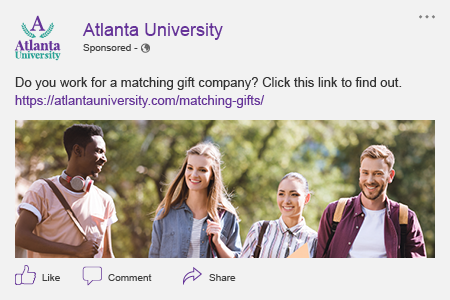
In all of your matching gift-related online posts, be sure to link out to additional educational resources that your audience can easily access to learn more about the opportunity.
4. Mention matching gifts in your higher ed institution’s fundraising appeals.
Do you have an upcoming fundraising campaign that you’d like to elevate with matching gifts? We recommend highlighting matching gift opportunities from the very beginning—such as directly within the donation appeal itself. This will not only drive corporate revenue in the form of employer donation matches but can also increase individual giving in terms of response rate and donation amount!
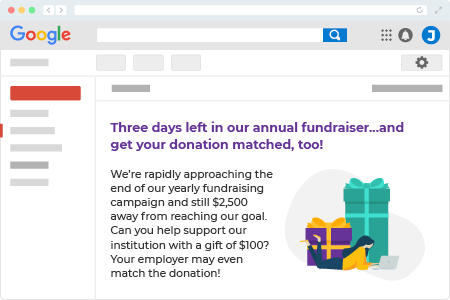
In fact, the aforementioned research states that 84% of surveyed donors are more likely to give if they know a company match is being offered. This results in a 71% increase in donation response rate compared to similar appeals that don’t mention matching gifts. At the same time, 1 in 3 donors reports a tendency to contribute larger amounts if a match is offered, resulting in a 51% increase in average donation amount when appeals incorporate matching gifts.
5. Get acquainted with top companies that match gifts to colleges and universities.
There are tens of thousands of companies that offer matching gift programs across every sector and scale of business, each with its own standards of which organizations are eligible to receive funding. The good news for you is that the vast majority of these programs are inclusive of higher education institutions like colleges and universities.
Here are a few generous (and higher ed-friendly) programs to keep an eye out for:
- Google — 1:1 match up to $10,000
- Salesforce — 1:1 match up to $5,000
- Verizon — 1:1 match up to $5,000
- Coca-Cola — 2:1 match up to $20,000
- PepsiCo — 1:1 match up to $10,000
- State Farm — 1:1 match up to $4,500
- Disney — 1:1 match up to $25,000

And these are just the tip of the iceberg! Explore other companies that match gifts to colleges and universities like yours by browsing other curated lists (such as this one and this one), conducting your own online research, or utilizing a matching gift company database tool.
6. Take a look at the companies your school’s alumni work for.
As a higher education institution, some of your most dedicated supporters are likely your school’s alumni. And when it comes to strategic matching gifts and higher education fundraising, the most essential data point you’ll need is your supporters’ employers. Thus, it makes sense to start by seeking information on the companies your alumni work for!
Once you have access to employment information, you can begin screening the companies against those with matching gift programs (such as those identified above) to identify likely match-eligible individuals.
You might already have some of this data, to begin with—particularly if your school attempts to keep track of alumni post-graduation. If you don’t know where your alumni are working, however, you can typically locate employment data through email domain screening, employer appends services, dedicated matching gift software, and more.
7. Collect employment information during the donation process.
Reiterating the fact that employment information is crucial for determining matching gift eligibility, another key strategy for collecting this data point is directly within the online giving experience—in your donation forms!
Donors already provide the institutions they support with some basic information about themselves and their gifts (such as their name, email, address, phone number, etc.) as they complete the giving process. What’s one more piece of information—their employer?
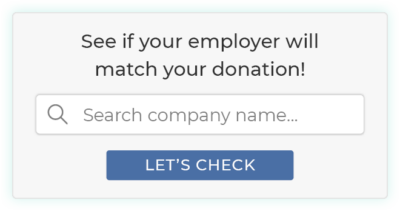
Many donors will provide this information when prompted within an optional field on the donation page. This is especially true if you make it clear what the information is for: to uncover their matching gift eligibility status.
8. Leverage giving momentum on your gift confirmation page.
Immediately after submitting a donation is when most school and nonprofit supporters are at their highest level of engagement. They’ve just completed a gift and are redirected to the institution’s donation confirmation page, thanking them for their contribution to the cause.
But did you know that this confirmation page is also a prime location for a specific call to action regarding a corporate donation match? They clearly support your school—and now they’re provided with an easy way to make an even more significant impact without digging back into their own wallets.
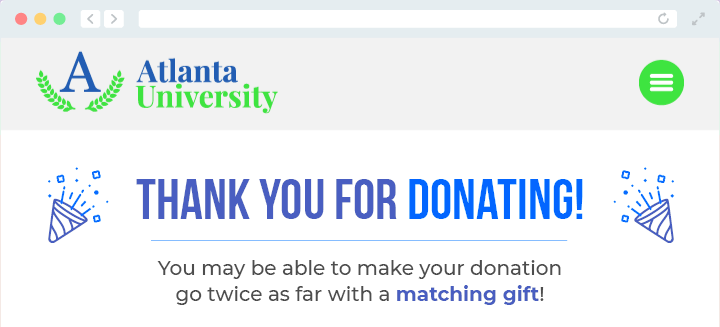
Be sure to mention matching gifts on your school’s confirmation screen, along with actionable suggested next steps to begin the matching process!
9. Guide donors to matching gift guidelines specific to their employers.
Let’s say a donor is informed about matching gift programs during the giving process they just completed. That sounds great—but they’re not sure if they are eligible to participate. They don’t remember hearing anything about gift-matching from their employer before, and they’re not likely to sift through their entire office policy handbook to locate the information.
That’s why your school should be taking the initiative to lead eligible donors directly to their employers’ company-specific matching gift program guidelines.
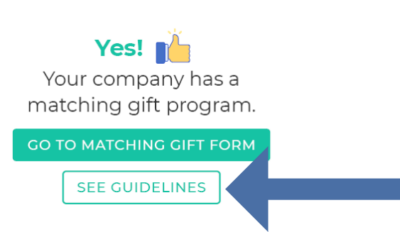 No manual research is required of the donor. Instead, they’re provided with their employing company’s:
No manual research is required of the donor. Instead, they’re provided with their employing company’s:
- Minimum matching donation amount
- Maximum matching donation amount
- Matching gift ratio
- Types of qualifying employees
- Types of qualifying institutions
- Matching gift submission deadlines
Equipped with this information, the donor can quickly and easily determine whether the gift they just made would be eligible for a match by their employer.
10. Share direct links to employers’ electronic giving forms.
Your donor has been informed of matching gift programs and has determined that their recent gift is eligible for a match by their employer. But they still don’t know how to complete their request, and they might (mistakenly) believe that the process is lengthy and complicated—especially if they don’t even know where to start!
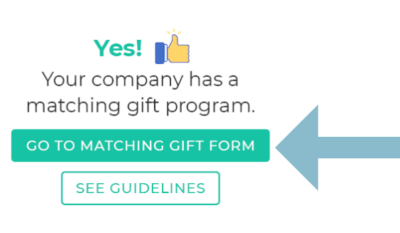 Again, we recommend guiding donors directly to the final destination: their employers’ submission forms. As you aim to do so, keep in mind that matching gift requests are typically completed using one of the following submission types:
Again, we recommend guiding donors directly to the final destination: their employers’ submission forms. As you aim to do so, keep in mind that matching gift requests are typically completed using one of the following submission types:
- Online forms
- Electronic portals
- Downloadable PDFs
- Paper documents
While most companies are moving into digital submission processes, such as online forms and portals, some businesses still utilize old-school paper documents to manage their employee requests. For those with digitized submissions, nonprofits and schools like yours are encouraged to provide donors with direct links to their employers’ request forms!
And if a company takes an offline approach to matching gift requests and management, be sure to share as many details as you can. For instance, see if you can provide contact information for an individual within the company that an employee can reach out to for more information.
11. Follow up on matching gifts and higher education opportunities post-transaction.
Some donors might take action to request their company match immediately from your donation confirmation screen. But some won’t—and in order to re-engage those individuals afterward, strategic follow-up efforts are essential.
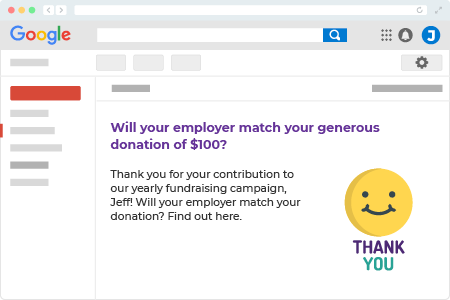
One of the best ways to do so is with post-transaction email messages that either inform donors about matching gift opportunities or remind them of their eligibility to participate. If you have access to your donor’s employer information (and the company’s matching gift guidelines and request forms), those are excellent resources to share at this point as well.
Keep in mind that the timing of these follow-ups is critical! You don’t want to send your matching gift emails too soon after a donation is processed (as donors will often discard immediate emails as being part of an automated gift receipt with no action needed). At the same time, you don’t want to wait too long and allow the engagement momentum to dwindle.
According to additional Double the Donation matching gift research, the sweet spot tends to be within 24 hours of the initial donation being made. In fact, matching gift email follow-ups sent within this time frame see a 53% open rate, which is more than 2.6 times the nonprofit average.
Plus, don’t forget to choose a compelling and actionable subject line!
12. Emphasize the doubled mission impact of matching gifts on your school.
Donors give because they see your institution making a positive impact on its students, faculty, alumni, and overall community. One of the key benefits of matching gift programs is that these donors are able to make their gifts go twice as far for a cause they care about: yours.
Make sure to emphasize this idea of doubling mission impact as you promote matching gift opportunities to your audience.
Here’s an example:
Let’s say your team is collecting donations for a new scholarship that will fund learning programs for incoming students. You’ve recently accepted a generous (and match-eligible!) donation of $5,000, or enough to cover a single individual’s scholarship. When you promote the matching gift opportunity to this donor, you’ll want to highlight that, by simply requesting a match from their employer, the donor can essentially provide impactful educational experiences to two students instead of one.
The same framework can be applied to any fundraising need your school is collecting funds for. Just focus on the tangible impact of your fundraising efforts—and double them!
13. Encourage donors to update your team when they’ve submitted their gift match.
Once a donor has submitted their matching gift request to their employer, the disbursement process itself can seem a bit blurry. How can your team know who has and has not completed their match? Or where a donor is in the request process overall?
Without a strategy in place, you likely won’t receive an update at all—until a corporate donation flows into your CRM. And even then, it can be difficult to know who the corporate match is associated with if you have no idea who actually submitted their matches in the first place!
Thus, the simplest way to track matching gift progress is by simply asking donors to keep your team in the loop. This can be as simple as incorporating a button or link in your matching gift communications that says something along the lines of “Click here to indicate that you’ve completed your matching gift request.”

14. Track data throughout the process to forecast revenue and make improvements.
You’ve likely heard the saying, “what gets measured gets managed.” In terms of matching gifts and higher education efforts, this can be particularly true—especially when fundraising teams already have a lot of critical tasks on their plate.
Thus, it’s essential that your team has the tools and strategies in place to effectively track data throughout the matching gift fundraising process. As donors request their matches, your team can view their movements and more accurately forecast incoming matching gift revenue.
Then, we also recommend recording data to determine the success of your matching gift fundraising and locate areas with room for improvement. This might include metrics such as:
- Matching gift eligible revenue identified
- Matching gift revenue collected
- Percentage of match-eligible donors
- Percentage of eligible donation matches collected
- Average matched donation amount
- Top companies contributing via matching gifts
The more you know about your incoming matches (as well as your matching potential), the better your team can adjust its efforts to continuously drive more revenue.
15. Automate your matching gift fundraising process with fundraising technology.
The final tip that we recommend for schools, and particularly higher education institutions, looking to make the most of matching gift fundraising opportunities is to invest in the best software available.
Luckily, it’s particularly simple to get up and running when you locate matching gift software that integrates with your existing higher education fundraising tools. For example, these top school donation platforms also integrate with the industry-leading matching gift automation provider, 360MatchPro. Once you have these tools on hand, you’ll be able to automate much of matching gift fundraising with just a few clicks!
This typically includes embedding an easy-to-use search tool within your online giving forms, hosting auto-populating matching gift program information on your gift confirmation screen, triggering personalized email follow-ups at the right time for each donor, and tracking valuable data insights throughout.
With the right tools, you can easily automate the process from start to finish—enabling your team to raise more through matching gift fundraising while requiring fewer investments of time, energy, and resources.
What’s Next?
Start putting these best practices into action at your school! Get your fundraisers on board, empower your team with innovative technology solutions, and begin promoting matching gift opportunities far and wide.
The sooner you get a plan in place for matching gift fundraising, the sooner you’ll see more matches flowing into your institution.
Find out how a top-notch alumni data strategy can equip your institution with valuable insights for matching gifts and other fundraising efforts at https://www.schoolmoney.org/alumni-data-points/.



